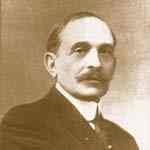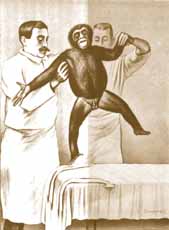
WHO INSERTS MONKEYGLANDS IN MILLIONAIRES
Thierry Gillyboeuf
[Spring 9 (2000):44-45]

|
THE FAMOUS DOCTOR
WHO INSERTS MONKEYGLANDS IN MILLIONAIRES Thierry Gillyboeuf [Spring 9 (2000):44-45] |
The first human xenotransplants were made in 1920 in France, by a professor
of Russian origin, Serge Voronoff (1866-1951). At the age of 18, he left Russia
to study medicine in Paris; he became a naturalized Frenchman in 1895. Dr.
Alexis Carrel taught his young friend, an ingenious and skillful surgeon,
the technique of transplanting. In 1896, Voronoff left for Egypt, where he
stayed until 1910. There, he took an active interest in eunuchs who, castrated
when they were children, revealed certain deficiencies. Voronoff was convinced
according to his own observations that testicles not only have a genital
function, but also that they act on the skeletal, muscular, nervous, and
psychological development of the individual. Already in June 1889, physiologist
Adolphe Brown-Séquard (1817-1894) injected himself under the skin
with an aqueous extract of dog and guinea pig testicles, ground up and mollified--an
opotherapy or juice treatment. In line with the eugenicist trend in medicine
of the 1920's and 1930's, Voronoff intended to "rejuvenate" human organisms
with a transplant of glands from chimpanzees and baboons, who were thus elevated
to the rank of brotherly species with mankind. "I dare assert," he wrote,
"that the monkey is superior to man by the sturdiness of its body, the quality
of its organs, and the absence of those defects, hereditary and acquired,
with which the main part of mankind is afflicted." For him, aging was the
result of a slowing down of endocrinal secretions, and particularly sexual
hormones. Brown-Séquard's experiments soon proved inefficient. But
Voronoff had already transplanted chimpanzee thyroids on people suffering
from thyroidal anomalies. And a transplant of a chimpanzee's bone on a wounded
soldier in 1915 suggested to him the idea of transplanting a monkey's testicle
in a man. According to him, glandular transplants would allow the production
of the hormone for an extended time period, contrary to opotherapy which
required repeated injections with not really convincing results. Between
1917 and 1926 Voronoff tested out his theory on animals, doing more than
500 homo-transplants on rams, goats, and even a bull. According to his observations,
older animals transplanted with younger animals' testicles regained lost
vigor.
| On the 12th of June, 1920, he performed the first (official) transplant of a monkeygland on a man. The monkeygland would be cut in pieces of about two centimeters long by a half centimeter wide and a few millimeters deep. The surgeon would then introduce two grafts in the scrotum, which he fixed with stitches taken off after eight days. Among forty men operated on during the 1920's-30's at a private clinic, the Villa Molière in Auteil, at a nursing home, Ambroise Paré in Neully, and the Rue Montaigne nursing home in [end page 44] Paris, we find listed nine employees, seven doctors, four engineers, four men of letters, three architects, three manufacturers, two attorneys, two university professors, one man of private means, one agronomist, one painter, and one worker. Eight of them were of foreign extraction. Nine were between the ages of 20 and 40; eighteen were between 41 and 60; seventeen were between 61 and 80. Voronoff's notoriety kept growing. In 1926 he wrote a book, Studies of Aging and Rejuvenation with Transplants, in which he explains and develops his theory, offering what appear to be quite convincing results. | 
|
By the early '30's, more than 500 men had been operated on in France, along with thousands of others all over the world--in the U.S.A., Italy, Russia, Brazil, Chile, and India. In England, where vivisection was strictly forbidden, surgeons transplanted human testicles. Voronoff was overwhelmed by his success. The supply of monkeys (chimpanzees and baboons) was insufficient. Beside the difficulties in catching them, many of the monkeys were killed on the spot for their fur, and many died during transport. As early as 1923, the governor general of occidental Africa suggested that monkey-houses could be put up in French Guinea to provide monkeys for France. Voronoff built his own monkey house in Menton. Transplant practice was now applied to women. To overcome the consequences of menopause, Voronoff transplanted ovaries from female monkeys into women. But he also attempted an odd experiment, transplanting a woman's ovary in Nora, a female monkey. He then inseminated Nora with human sperm .... with no result. Inspired by this odd experiment, the French writer Félicien Champsaur wrote the novel Nora, la guenon devenue femme (Nora, the Monkey Turned Woman)--one of the unexpected results of Voronoff's notoriety. Though he was still convinced of the validity of his theory and the efficiency of his methods, Voronoff was forced to end his experiments because of pressure from the scientific community, which was quite censorious and doubtful about his results, and because of the opinion of the public, who eventually realized that they had been misled by "the famous doctor who inserts / monkeyglands in millionaires a cute idea n'est-ce pas?" (CP 243).
SPRING Contents # 9